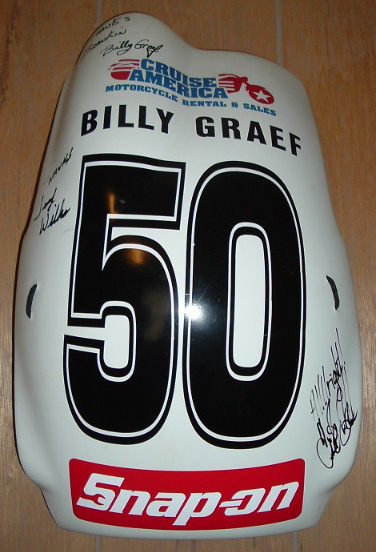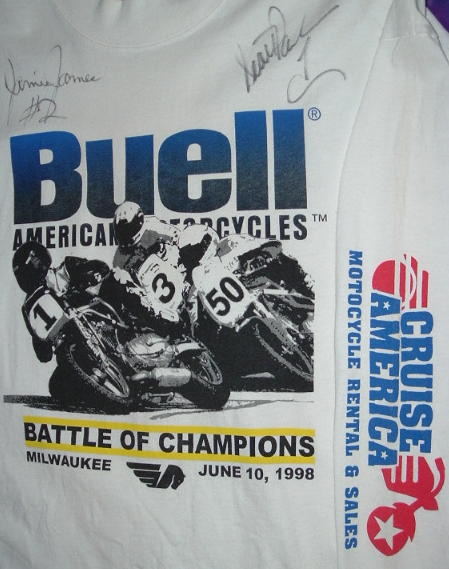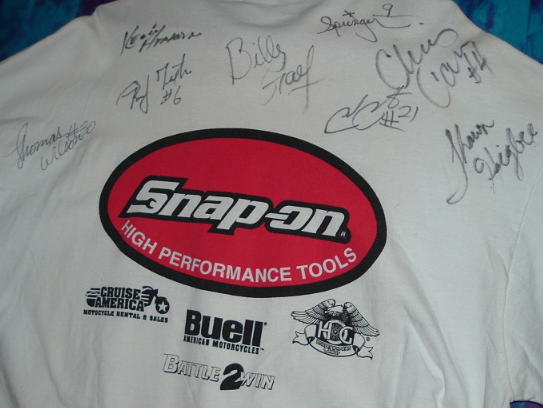| Author | Message | ||
Ezetobebad__uk |
http://www.mototuneusa.com/break_in_secrets.htm Looking for views on using this method to break in an engine, The link above goes into great detail explaining the reasons why it is beneficial to break in an engine hard & fast, All views on this subject are greatly appreciated. On a Dyno: Warm the engine up completely !! Do 3 – half throttle, 40-60% max rpm runs,Then Let it Cool Down For About 15 Minutes then do 3 – 3/4 throttle, 40-80% max rpm ,Let it Cool Down For About 15 Minutes next do 3 – full throttle, 30-80% max rpm runs 30% - 100% of your engine's max rpm Let it Cool Down For About 15 Minutes Go For It !! eze :confused: ps - how long does it take an engine to warm up ? | ||
Mmmi_grad |
Are you serious? Scuff marks are not normal on the trust area of the piston?????????? I dont know what jap world this guy lives or what planet anyway but i find this website to be total crap compared to american motorcycles. Our harley engines will run good with even .006 clearance thrust area clearence. Thiis from him strikes me as comody for the first read???????? | ||
Ezetobebad__uk |
Are you serious? No I am ezetobebad UK, perhaps you are confusing me with AN Other - badweb site user?????????????????????????????????????????????????????????????? | ||
Rocketman |
Not sure I'd agree with the guys idea that metals involved don't become heat treated as the motor is broke in. As far as I'm aware some fresh made metals change in their make up as heat cycles are applied. Once changed they are changed forever. Recently Kevin Ash wrote a technical bulletin in MCN UK about this same principle applied to the breaking in of disc brake rotors. Seems there's a huge emphasis on ring seal in this guys ideology. I wouldn't argue with that but I can't get my head round why hids process alone gives the ultimate ring seal required to support his theory. Sceptical thanks, so meanwhile I'll continue to play it a little safe until I can afford to risk three hundred motors of mine or someone else's. That said, I'm all for new ideas and I like the guys madness. Good topic. Wonder what Pammy and Wes think? Rocket | ||
Wyckedflesh |
I find it difficult to believe that 8+ major motorcycle manufacturers recommend a break in that is really quite the same for everyone with slight differences in oil change mileages would not recommend this guys deal if it worked so well. | ||
Ezetobebad__uk |
I too am sceptical, for instance he shows no dyno graphs to support his claims, he also states how racers using his method pass factory racers on the straights at end of season, why would this be so if we consider that factory teams rebuild engines after every race? i recall an mcn article that reported modest gains in bhp when breaking an engine in quickly on a 900 fireplace engine, but they had reservations about long term reliability & oil consumption & if i recall correctly the power gained was 4/6 bhp | ||
Irish |
I'm a new Bueller, '02 S3T. My question-Do they all shake hard enough to rattle your teeth from idle to 1500rpm. BTW It came with a Power Commander don't know the settings. | ||
Ezetobebad__uk |
& what prey tell has your post to do with this thread paddy? lol | ||
Aaomy |
hummm,, arnt most hardened valve seats partly soft when installed and cut originally and the initial heat cycles with the combination of the valves hammering them "finishing the process", i dont really know whose seats harley uses or what material they choose. neither for or against, just trying to add my two cents. what ever you choose to do make sure you fully allow you engine to come to temp and and that you have good oil circulation before attempting his process. but guess that goes either way. | ||
Aesquire |
Irish, yes. The vibration isolation system is meant to work at riding speed. It will dance across a driveway while warming up. A Buell ain't a Hog, more a wild boar. Keep the idle up about 1100, and don't lug it, it spins up faster than a Sportster too. I agree with the Mototune guy up to a point. Warming up the engine prior to asking big HP of it is important. He's doing Honda 600's and the like, I have not read any HD info there. ( I'll go look again ) | ||
Oldog |
ez, uk Interesting read I def-fin-ately disagree! more than the rings are breaking in in a "green" Buell engine. I believe that Aaomy and Rocket are likely right about heating cycles and metals changes. My own experience 3 new big road bikes and 6 or 8 LARGE piston compressors (7 3/4" bores) I think that mr moto is off the mark also I think that HD has built and destroyed a few more motors than he has so my inclination is to do what they say in that you are going to do a build see what your guy says I would like to hear Aaron Wilsons' thoughts on this as well as Wes and Pammys'  | ||
Bomber |
Rocker's right -- metals DO change as they heat cycle (but can generally be returned to their "fresh" state through proper application of heat again, btw) -- and engine is not an engine -- my 99 ford came with the instructions to drive it like I stole it right off the floor, and it lived very nicely, thanks -- my M2 came with very different instructions concerning break-in, and, once followed (longest 500 miles of my life, btw), it, too, is going strong many thousands of miles later I think it's a little off the page to say that engines should be broken in in a specific manner -- way to many variable -- liquid vs air cooled, cyl/piston/ring materials and expansion rates, the list goes on -- urbans legands ARE fun, though, aren't they? | ||
1313 |
Anyone have (and actually ride) one of the '98 S1W Battle of Champions 'Race' Bikes? When those bikes were broken in prior to the 'race', there was an explicit procedure for breaking them in: 1. Take it easy for the first 50 miles (similar to the manual). 2. Ride the tar out of it! I, myself, have broken in all the bikes I've owned (air cooled Buell, 3 air cooled H-D's and 1 water cooled H-D) per the recommendations in the manual and have had very good results. 1313 | ||
Court |
1313: I have my shirts (remember the Snap-On / Buell Race of Champions shirts?) AND 3 rolls of film shot at the Races! I have, being held as evidence, some great ones of you! | ||
1313 |
 Evidence?!?! Ha! I bet they look nothing like me anymore!  Would be pretty cool to see as I don't have many pictures of myself back when I had long hair. I sure hope you didn't get a pic of the burnout I did with Billy Graef's bike after the race...Yes, that was after I cleaned the bird guts off the bike. Would be pretty cool to see as I don't have many pictures of myself back when I had long hair. I sure hope you didn't get a pic of the burnout I did with Billy Graef's bike after the race...Yes, that was after I cleaned the bird guts off the bike. Oh yeah, the infamous Motocycle shirt - signed by all the racers, even.   1313 | ||
Sandblast |
eze :confused: Thats okay, we dont expect much of the English...  | ||
Blake |
Yeah, what do Pammy and Wes say on this. Good point ballistic man. | ||
Pammy |
Well what I have to say concerns the procedure at Cycle-Rama. I certainly can't speak for the rest of the mechanical world. As you know some things that happen(good or bad) just cannot be explained. When we build a bike (mild or wild), we heat cycle the motor a few times(depending) on the dyno. It can easily be done on ones garage floor as well. This allows all the metal components to grow with one another and become comfortable with each other, like new friends. You do know different metals grow at different rates at different heat ranges. Now, breaking in a motor is required mostly to seat the rings to the cylinder wall. This occurs when the pressure inside the cylinder is great enough to cause the rings to expand and rub the cylinder wall all the way around with equal pressure. Pressure in the cylinder becomes great enough for this to occur when power settings are at least 60% of total power. Now this (again in my mind) does not mean "ride it like you stole it". Because remember the new components inside are just getting all warm and friendly with one another. It does mean that just heat cycling the motor won't get the job done. Keep in mind that on a new build you are also making sure that there are no "bugs" in the motor. I don't know about you but I would rather find out something was amiss at a lower RPM than at wide open...(not that that would EVER happen) We recommend at least 500 miles of gentle riding and a subsequent oil change. Better safe than sorry is my motto... | ||
Mmmi_grad |
this is an endless debate, crack open any Harley service manual and check out the close clearences, start with the rod bearing and just go from there. When I learned about rebuilding these motors and what shops do for customers its better to interview the customer and build the engine accordingly, like for someone who wont be easy with it at first.......then set up the motor on the loose side and the motor will be fine. | ||
Captpete |
Pammy, you have such a way with words. I can just see all those parts hugging each other and rubbing each other's backs and shoulders a little bit... but not enough to get each other too hot, of course.  (Message edited by captpete on April 26, 2005) | ||
Trac95ker |
I found this on the hastings website: http://www.hastingsmfg.com/Service%20Tips/breakin_procedure.htm http://www.hastingsmfg.com/Service%20Tips/compression_ring_seating.htm |